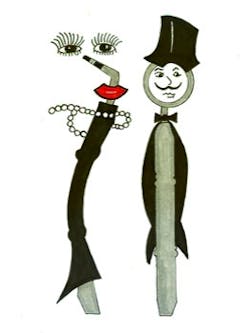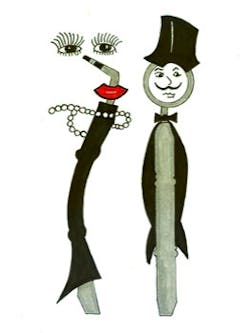The Life of the Party
Chemical indicators are similar to an RSVP for a social gathering
by Gaylene Baker, RDH, BS
You’ve just completed your dental procedure, cleaned the treatment room, grabbed the next setup of instruments, and are prepared to do it all again. It’s an easy routine. But today you’re a little daydreamy and not focused on work. Instead you’re thinking of everything you need to do for the upcoming fancy dinner dance. It’s an annual gala and always the talk of the town. You’re wondering if the tux is ready. Should you wear gloves with your dress? There is so much etiquette to follow for such an event.
The next patient is seated in the treatment chair; you begin another appointment. As you rip open the sterilized instruments, you’re startled back to reality. While gazing at the bands that denote the group of instruments, you notice that they look like a lovely pearl white and tuxedo black combination.
But wait! That instrument color combination was used earlier in the day. Peering over your eye magnification to catch a quick glance at the clock, you notice it’s 1 p.m. Exactly what time was this setup used previously? You’re not sure, but the instruments were cleaned, packaged, and put in the sterilizer. The package indicator has changed color.
This scenario makes you wonder, what is the proper etiquette for sterilization and use of dental instruments? After all, if there is so much information on which fork or spoon to use at a dinner, then there must be information regarding the proper sterilization of dental instruments. You can refer to the American Association for Medical Instrumentation (AAMI) and the Centers for Disease Control (CDC) for proper instrument handling and sterilization information. You want your instruments to be properly prepared and sterilized for patient use, just like you want to be prepared for the gala.
The sterilization process
It’s Saturday, the day of the big event, time to get polished and chic. You need a nice hot bath to unwind. You pour your favorite bath salts into the tub, get into the water and relax. The steam wafts up into your face, making you wonder how steam sterilizers really work.
Charles Chamberland invented the first real steam sterilizer in 1880. Steam sterilization is one of several techniques used for destroying microorganisms on inanimate objects. It involves the use of steam under pressure, delivered at a particular temperature for an appropriate amount of time. Sterilization occurs as the underlying heat of condensation is transferred to the sterilizer load, causing it to heat rapidly. Heating denatures any microorganisms remaining after the cleaning process.
There are quality control measures for monitoring the sterilization process that should be reviewed with the personnel who will be running the equipment. It is essential that the three critical steps in testing the efficacy of the sterilizer process are followed. These include physical monitoring, the use of external and internal chemical indicators, and the use of biological indicators.
• Physical monitoring includes recording the sterilizer’s temperature, time, and pressure on digital printouts, displays and/or gauges. Physical monitoring includes recording the sterilizer’s temperature, time, and pressures on digital printouts, displays, and/or gauges. Physical monitoring helps detect malfunctions sooner. This allows for more timely corrective actions.
• Chemical indicators (CI) should be used in conjunction with physical monitoring and biological indicator testing. Best practices recommend that external and internal CIs be used for all items being sterilized. CIs are arranged in classes depending on the number of sterilization variables or sterilization controls that must be satisfied for a chemical or color reaction to occur.
• Biological indicators (BI), also known as spore tests, are paper filter strips, capsules, or ampoules that contain at least one million known living and highly resistant spores. If the resistant spores are eradicated during the sterilization process, it can be concluded that the sterilization process was effective. BIs provide the only way the sterility process can be measured. Sterilizer manufacturers validate their sterilizers by using BIs, and therefore BIs should be used to check the sterilizer’s effectiveness on a frequent routine basis.
There are many factors that can contribute to a sterilization failure. These include inadequately cleaned instruments being placed in the sterilizer, improper air/steam mixture quality due to superheating of the steam or preheating of the instruments to be processed, operator error including incorrect packaging of instruments, and improper loading of the sterilizer.
It’s time to step out of the bathtub before the pruning effect on the skin is irreversible, much like the effects of steam sterilization on pathogenic microbes.
What are chemical indicators?
Chemical Indicators (CIs) are similar to an RSVP for a social gathering. Just as the reply to an invitation assists the host or hostess with party preparation, CIs are used for monitoring the sterilization process, and are intended to respond to all or part of the physical conditions of the sterilization cycle in the sterilizer chamber. CIs usually consist of a sensitive ink dye that changes color under certain conditions.
There are different types of CIs, and each measures a different variable of the sterilization cycle. The choice of which CI to use during sterilization should be determined by the user after understanding what each indicates, and based on what information is desired regarding the sterilization cycle. Each CI measures for a different sterilization variable. The critical steam sterilization variables are time, temperature, and presence of steam. Knowing which sterilization class is being used allows awareness of what variables are being measured during the steam sterilization cycle. CIs are convenient and inexpensive, and indicate that the item or package has been exposed to the sterilization process.
The Life of the Party
The evening of the big gala has arrived. Hair is done, pearls are on, and gown is selected, but which shoes to wear? Looking in the closet, everything is organized neatly and by color. Do all hygienists do this? That answer will have to wait for another article. The question now is which shoes? Silver shoes are good, but do you opt for the comfortable low heel, the moderate yet elegant heel, or the magnificent five-inch platform Louis Vuitton heels? It is most certainly the latter. After all, now that you know what kind of statement you want to make, you must make it. You should be the life of the party, and your treatment instruments should be free of life. That is why in conjunction with CIs, you physically monitor the sterilizer and use a BI at least once a week to determine the efficacy of the sterilization process with your sterilizer. Now, go dance the night away and be the life of the party! Monday and another workday will be here soon enough.
Monday morning
As you watch the periodontal probe and mirror dance around the patient’s mouth, you now know that you properly prepared for the gala. How can you be sure that your instruments are properly prepared for the next patient? Understanding CIs and sterilization protocol can be tricky. Training is the key to success for you, the sterilization coordinator, and the entire dental team.
The training includes properly cleaning and disinfecting instruments, knowing what type of CI to use (both externally and internally), and that a BI must be run on every sterilizer once a week or with every load that has an implantable device. Just as you put effort into choosing the proper attire for the gala, your should put effort into sterilization. When you know what you need to do for proper sterilization, you must follow through — anything else would be a faux pas. There are many different sterilization indicators. Make sure you know what you are using and what it is telling you.
Gaylene Baker, RDH, BS, graduated from the University of Iowa with a bachelor’s degree in dental hygiene. She has been employed in a variety of private practices for more than 25 years. Currently, Gaylene is employed by Crosstex International as the Midwest sales consultant.
References
• Association for the Advancement of Medical Instrumentation www.aami.org.
• Centers for Disease Control and Prevention (CDC). Guidelines for infection control in dental health-care settings, 2003. MMWR 2003 www.cdc.gov.
• USAF Infection Control Guidelines for Dentistry, April 2010.
• Alcamo’s fundamentals of microbiology: Body systems edition by Jeffrey C. Pommerville.
Chemical Indicator classes
• Class 1: These are referred to as process indicators. They indicate that a pack has been exposed to a sterilization process. Process indicators are intended for use as an external indicator to distinguish between processed and unprocessed items.
• Class 2: These indicators are used in a specific test procedure called a Bowie-Dick test, which measures the ability of the sterilizer to create the vacuum needed for steam penetration.
• Class 3: These indicators measure a single variable of sterilization. They react to only one of the critical variables of sterilization and are designed to specify exposure to a sterilization process at a stated value of the chosen variable.
• Class 4: Multivariable indicators are those that react to two or more of the critical variables of sterilization and are intended to indicate exposure to a sterilization cycle.
• Class 5: These are referred to as Integrating Indicators and are designed to react to all the critical variables of a sterilization cycle.
• Class 6: These are referred to as Emulating Indicators and are designed to react to all the critical variables of a specified sterilization cycle.
Past RDH Issues

